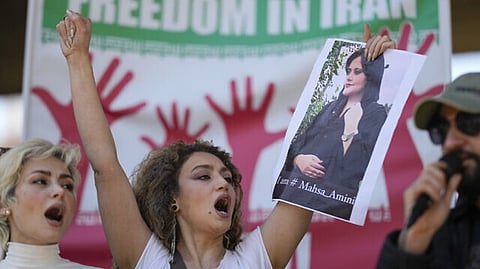

NEW DELHI: Three months after Mahsa Amini, a 22-year-old Kurdish Iranian woman died after being apprehended by Iran’s cultural guardians on account of ‘inappropriate’ attire, the nation’s attorney general announced its morality police, known formally as the Garsht-e-Ershad has been disbanded.
he news was greeted with cheers in Tehran where Amini’s death had sparked off a wave of protests against the enforcement of the hijab rule, and the heavy-handed approach of the morality police.
Thousands of women in Iran had expressed their dissent by chopping off their hair and burning the headscarf in public, with similar displays of resistance in capitals globally.
The reprieve, which many observers see as a temporary measure to alleviate the angst of the nation, was a hard-won victory, for the demonstrators, not to mention, a win that has cost many lives.
Over 300 people were killed in the unrest, which includes dozens of members of the security force.
Iran Human Rights, an Oslo based NGO, said the actual fatality count hovers around 448 people since September this year, when the protests kicked off in Tehran.
Thousands, including prominent Iranian footballers and members of the artistic fraternity have been arrested.
The laws pertaining to the nation’s conservative dress code were imposed after the 1979 Islamic Revolution that led to the ouster of the US-backed Shah and the takeover of Iran’s polity by hardline Supreme er Ayatollah Khomeini who ran the country as a theocracy until his death in 1989.
The morality police was tasked with enforcing these dress codes that had become an ideological lynchpin of the ruling clerical establishment and central to its identity.
In spite of mass protests even back then, long black robes and chadors became the default norm for women’s attire.
Amid a renewed push for such rules by its new ultraconservative president, this time, the laws have invited the wrath of demonstrators fed up with the absolute lack of agency for women, political repression, censorship, economic mismanagement and corruption. And now, they have challenged the very seat of power in Tehran, the Supreme er Ayatollah Ali Khamenei, who the agitators want to unseat, and subsequently put an end to the Islamic Republic.
While the interior ministry, which is in charge of the morality police, has offered no confirmation on the closure of the agency, authorities are deliberating on relaxing the hijab rule.
This rare concession offered to citizens is a fallout of the international embarrassment caused to the regime by the protesters, who have been relentless in their agitation.
To top it off, the nation is also undergoing the debilitating impact of the economic crisis, as a result of sanctions imposed by the US, which had prompted parliamentarians to ‘pay attention to the real demands of its people.’
It might be premature to presume Iran’s dismantling of the morality police will transform it overnight into a poster child for democracy and protection of civil rights.
However, the message that has gone out into the world, much like the Arab Spring, is that women, and people on the whole in Tehran, are unwilling to turn the other cheek and walk away from injustices.
The fact that men and women in the country stood shoulder to shoulder in pursuit of righting a wrong even as they were threatened with death and disappearance speaks volumes about the power of the collective. And that is no mean feat.
Visit news.dtnext.in to explore our interactive epaper!
Download the DT Next app for more exciting features!
Click here for iOS
Click here for Android